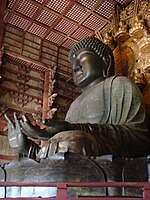Kisshōten
吉祥天 or 吉祥天
(romaji: Kichijōten)
(RR: Gilsang Cheon)
Wylie: lha mo chen mo dpal
 Religion portal
Religion portalKisshōten (吉祥天, lit. "Auspicious Heavens"), also known as Kichijōten, Kisshoutennyo (吉祥天女), or Kudokuten (功徳天), is a Japanese female deity, adapted via Buddhism from the Hindu goddess Lakshmi. Kisshoutennyo is sometimes named as one of the Seven Gods of Fortune (fukujin), replacing either Jurōjin or Fukurokuju.[1] For example, in the 1783 edition of the Butsuzōzui compendium (reprinted in 1796), Kichijōten replaces Fukurokuju as one of the seven fukujin.[2] She is considered to be the goddess of happiness, fertility, and beauty.[1][3][4] Kisshoutennyo's iconography is distinguished by the Nyoihōju gem (如意宝珠) in her hand,[5] Kisshōten and the Nyoihōju gem are both represented by the symbol of the kagome.
When Kisshoutennyo is counted among the seven fukujin[2] and fellow Fukujin Daikoku is regarded in feminine form,[6] all three of the Hindu Tridevi goddesses are represented in the Fukujin, with Daikoku representing Parvati and Benzaiten representing Saraswati.
See also
- Buddhist Tenbu (天部) deities
- Fukujin (福神) deities
- Hinduism in Japan
- Kagome crest
- Kagome lattice
- Kisshō Tennyo (manga)
- Lakshmi
- Nyoihōju (如意宝珠) wishing gem
- Satkona
- Vasudhara (Bodhisattva of good fortune, wealth, fertility, prosperity)
References
- ^ a b "Wooden figure of Kichijōten". The British Museum. Retrieved 27 August 2012.
- ^ a b "Butsuzōzui (Illustrated Compendium of Buddhist Images)" (in Japanese). Ehime University Library. 1796. p. (077.jpg). Archived from the original (digital photos) on 10 October 2018. Retrieved 14 May 2016.
- ^ "Kichijoten Japanese Lucky Goddess of Beauty". 10 February 2023. Archived from the original on 10 February 2023. Retrieved 1 March 2023.
{{cite web}}: CS1 maint: bot: original URL status unknown (link) - ^ "Kisshōten (Kichijōten)". Philadelphia Museum of Art. Retrieved 27 August 2012.
- ^ Neighbour-Parent, Mary. "Kichijouten 吉祥天". JAANUS. Atsumi International Scholarship Foundation.
- ^ "Butsuzōzui (Illustrated Compendium of Buddhist Images)" (in Japanese). Ehime University Library. 1796. p. (059.jpg). Archived from the original (digital photos) on 10 October 2018. Retrieved 14 May 2016.
External links
 Media related to Kichijouten at Wikimedia Commons
Media related to Kichijouten at Wikimedia Commons
- v
- t
- e
如来部 (Nyorai-bu)

菩薩部 (Bosatsu-bu)
明王部 (Myōō-bu)
天部 (Ten-bu)
- Four Heavenly Kings (Shitennō)
- Eight Legions (Hachi-Bushū)
- Twelve Devas (Jūni-ten)
- Twelve Heavenly Generals (Jūni Shinshō)
- Twenty-Eight Legions (Nijūhachi-Bushū)
- Sarasvatī (Benzaiten)
- Vaiśravaṇa (Bishamonten)
- Śakra (Taishakuten)
- Brahmā (Bonten)
- Maheśvara (Daijizaiten)
- Mahākāla (Daikokuten)
- Ḍākinī (Dakiniten)
- Yama (Enma-Daiō)
- Gigeiten
- Skanda (Idaten)
- Īśāna (Ishanaten)
- Pṛthvī (Jiten)
- Gaṇapati (Kankiten)
- Hārītī (Kishimojin)
- Apsara (Hiten)
- Kalaviṅka (Karyōbinga)
- Lakṣmī (Kisshōten)
- Mārīcī (Marishiten)
- Vajrapāṇi (Niō)
垂迹身部 (Suijakushin-bu)
- Akiha Gongen
- Ishizuchi Daigongen
- Ochi Daigongen
- Kumano Gongen
- Sanki Daigongen
- Zaō Gongen
- Suzuka Gongen
- Seiryū Gongen
- Tateyama Gongen
- Chimyō Gongen
- Nezu Gongen
- Hakusan Gongen
- Haguro Gongen
- Hachiōji Gongen
- Hiryō Gongen
- Sannō Gongen
- Futara Gongen
- Yuga Daigongen
- Hikosan Gongen
- Shiromine Gongen
- Izuna Gongen
- Atago Gongen
- Konpira Daigongen
高僧・祖師部 (Kōsō・Soshi-bu)
- Zen
- Tendai
- Shingon
- Pure Land
- Shugendō
- Nichiren
- Japanese mythology
 | This article relating to Japanese mythology is a stub. You can help Wikipedia by expanding it. |
- v
- t
- e
 | This article related to religion in Japan is a stub. You can help Wikipedia by expanding it. |
- v
- t
- e












